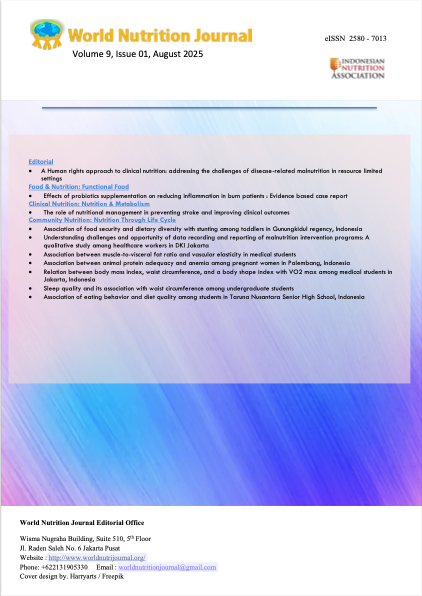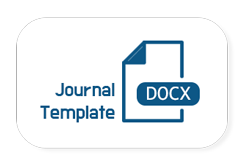Association of eating behavior and diet quality among students in Taruna Nusantara Senior High School, Indonesia
Abstract
Background: Poor adolescent diet quality is influenced by family eating habits, media promoting unhealthy foods, and body image pressures, leading to disordered eating, neglect of health considerations, and obesity. Even in controlled environments like boarding schools. Objective: This study aims to assess association between eating behavior and dietary quality among students in Taruna Nusantara Senior High School (TN-SHS), Indonesia. Methods: A cross-sectional study with 200 subjects aged 15-18 was conducted in January 2024. Participants were purposively sampled from TN-SHS boarding school. Data was collected using the Dutch Eating Behavior Questionnaire (DEBQ) and Diet Quality Index International (DQI-I), along with sociodemographic information, nutritional status, and physical activity. Analysis was performed using SPSS 29, employing multiple linear regression to examine the relationship between eating behaviors and diet quality. Results: There was strong relationship between eating behavior and diet quality on different days, revealing that restrained eating correlates with better diet quality on average days (r=0.158, p=0.026), while external eating is linked to poorer diet quality. The association between eating behavior and diet quality on weekdays is weaker than on weekends. External eating consistently reduces diet quality across all periods (β=–1.380 to –1.854, p<0.01). Males exhibiting lower diet quality (β=–3.021 to –4.904, p≤0.002) and higher pocket money associated with improved diet quality, particularly on weekends (β=–3.633, p=0.021). Conclusion: The study findings highlight the importance of managing external eating behaviors such as emotional eating, social eating, mindless eating, and binge eating, and suggest avenues for targeted interventions to promote healthier dietary habits.Downloads
References
Badan Kebijakan Pembangunan Kesehatan. SURVEI KESEHATAN INDONESIA (SKI) [Internet]. JAKARTA; 2023 [cited 2025 Feb 17]. Available from: https://drive.google.com/file/d/1rjNDG_f8xG6-Y9wmhJUnXhJ-vUFevVJC/view?usp=sharing
Agustina R, Meilianawati, Fenny, Atmarita, Suparmi, Susiloretni KA, et al. Psychosocial, Eating Behavior, and Lifestyle Factors Influencing Overweight and Obesity in Adolescents. Food Nutr Bull. 2021;42(1_suppl).
Ejigu BA, Tiruneh FN. The Link between Overweight/Obesity and Noncommunicable Diseases in Ethiopia: Evidences from Nationwide WHO STEPS Survey 2015. Int J Hypertens. 2023;2023.
Mboi N, Syailendrawati R, Ostroff SM, Elyazar IRF, Glenn SD, Rachmawati T, et al. The state of health in Indonesia’s provinces, 1990–2019: a systematic analysis for the Global Burden of Disease Study 2019. Lancet Glob Health. 2022;10(11).
Tichenor M, Sridhar D. The global burden of disease study. institute for health metrics and evaluation. Wellcome Open Res. 2020;4.
Kesehatan K. Hasil Utama Riset Kesehatan Dasar. Kementrian Kesehatan Republik Indonesia. 2018;
Zemrani B, Gehri M, Masserey E, Knob C, Pellaton R. A hidden side of the COVID-19 pandemic in children: the double burden of undernutrition and overnutrition. Int J Equity Health. 2021;20(1).
Ammar A, Brach M, Trabelsi K, Chtourou H, Boukhris O, Masmoudi L, et al. Effects of COVID-19 home confinement on eating behaviour and physical activity: Results of the ECLB-COVID19 international online survey. Nutrients. 2020;12(6).
Deschasaux-Tanguy M, Druesne-Pecollo N, Esseddik Y, De Edelenyi FS, Allès B, Andreeva VA, et al. Diet and physical activity during the coronavirus disease 2019 (COVID-19) lockdown (March-May 2020): Results from the French NutriNet-Santé cohort study. American Journal of Clinical Nutrition. 2021;113(4).
Kim S, Haines PS, Siega-Riz AM, Popkin BM. The Diet Quality Index-International (DQI-I) Provides an Effective Tool for Cross-National Comparison of Diet Quality as Illustrated by China and the United States. In: Journal of Nutrition. 2003.
Williams J, Townsend N, Rayner M, Jayawardena R, Katulanda P, Manoharan S, et al. Diet quality of adolescents in rural Sri Lanka based on the Diet Quality Index-International: findings from the “Integrating Nutrition Promotion and Rural Development” project. Public Health Nutr. 2019;22(10).
Segovia-Siapco G, Paalani M, Oda K, Pribis P, Sabaté J. Associations between avocado consumption and diet quality, dietary intake, measures of obesity and body composition in adolescents: The teen food and development study. Nutrients. 2021;13(12).
Damayanti. Buku Pegangan Ilmu Gizi Dasar. PT Penerbit IPB Press. 2020.
Azrimaidaliza, Resmiati, Famelia W, Purnakarya I, Firdaus, Yasirly K. Buku Ajar Dasar Ilmu Gizi Kesehatan Masyarakat. Vol. 53, Journal of Chemical Information and Modeling. 2020.
Proverawati. Obesitas dan Gangguan Perilaku Makan pada Remaja. Vol. 34, Bangladesh Journal of Medical Science. 2015.
Sulistyoningsih H. Gizi Untuk Kesehatan Ibu dan Anak. Vol. 2011, 1. GIZI UNTUK IBU 2. GIZI UNTUK ANAK 3. GIZI - KESEHATAN,Gizi untuk kesehatan ibu dan anak / Hariyani Sulistyoningsih. 2011.
Agustina R, Nadiya K, El Andini A, Setianingsih AA, Sadariskar AA, Prafiantini E, et al. Associations of meal patterning, dietary quality and diversity with anemia and overweight-obesity among Indonesian schoolgoing adolescent girls in West Java. PLoS One. 2020;15(4).
Setyowati ND, Riyanti E, Indraswari R. Faktor-Faktor Yang Berhubungan Dengan Perilaku Makan Remaja Putri Dalam Pencegahan Anemia Di Wilayah Kerja Puskesmas Ngemplak Simongan. Jurnal Kesehatan Masyarakat. 2017;5.
Mardalena I. Dasar-dasar Ilmu Gizi dalam Keperawatan Konsep dan Penerapan pada Asuhan Keperawatan. Pustaka Baru press. 2021;
Cole N, Fox MK. Diet Quality of Americans by Food Stamp Participation Status: Data from the National Health and Nutrition Examination Survey, 1999-2004. Mathematica Policy Research Reports. 2004;
Hunot-Alexander C, Beeken RJ, Goodman W, Fildes A, Croker H, Llewellyn C, et al. Confirmation of the Factor Structure and Reliability of the ‘Adult Eating Behavior Questionnaire’ in an Adolescent Sample. Front Psychol. 2019;10.
Permendikbud No. 1. (Permendikbud) Nomor 1 Tahun 2021 tentang Penerimaan Peserta Didik Baru Jenjang TK, SD, SMP, SMA dan SMK. Permendikbud. 2021;
Ragelienė T, Grønhøj A. The influence of peers′ and siblings′ on children’s and adolescents′ healthy eating behavior. A systematic literature review. Appetite. 2020;148.
Liu KSN, Chen JY, Kang Q, Sun KS, Tsang JPY, Ip P, et al. Assessing family influence on adolescent healthy eating: insights from knowledge, attitudes, and practices in a cross-sectional survey in Hong Kong. BMC Public Health [Internet]. 2025 Dec 1 [cited 2025 Jun 22];25(1). Available from: https://bmcpublichealth.biomedcentral.com/articles/10.1186/s12889-025-22999-4?utm_source=chatgpt.com
Kurniawan M wahid wahyu, Widyaningsih TD. Hubungan Pola Konsumsi Pangan dan Besar Uang Saku Mahasiswa Manajemen Bisnis dengan Mahasiswa Jurusan Teknologi Hasil Pertanian Universitas Brawijaya terhadap Status Gizi. Jurnal Pangan dan Agroindustri. 2017;5(1).
Praditasari JA, Sumarmik S. Asupan lemak, aktivitas fisik, dan kegemukan pada remaja putri di SMP Bina Insani Surabaya. Media Gizi Indonesia. 2018;13(2).
Nisa H, Fatihah IZ, Oktovianty F, Rachmawati T, Azhari RM. Konsumsi Makanan Cepat Saji, Aktivitas Fisik, dan Status Gizi Remaja di Kota Tangerang Selatan. Media Penelitian dan Pengembangan Kesehatan. 2021;31(1).
Nabawiyah H, Khusniyati ZA, Damayanti AY, Naufalina MD. Hubungan pola makan, aktivitas fisik, kualitas tidur dengan status gizi santriwati Pondok Modern Darussalam Gontor Putri 1. Darussalam Nutrition Journal. 2021;5(1).
Jamil SNA, Sandra L, Sutrisno E, Purnamasari S, Mardiyah U, Fitriani E, et al. Ekologi Pangan Dan Gizi Masyarakat. Penerbit Perkumpulan Rumah Cemerlang Indonesia (PRCI. 2021.
Lehtisalo J, Erkkola M, Tapanainen H, Kronberg-Kippilä C, Veijola R, Knip M, et al. Food consumption and nutrient intake in day care and at home in 3-year-old Finnish children. Public Health Nutr. 2010;13(6 A).
Rothausen BW, Matthiessen J, Hoppe C, Brockhoff PB, Andersen LF, Tetens I. Differences in Danish children’s diet quality on weekdays v. weekend days. Public Health Nutr. 2012;15(9).
Rothausen BW, Matthiessen J, Andersen LF, Brockhoff PB, Tetens I. Dietary patterns on weekdays and weekend days in 4-14-year-old Danish children. Br J Nutr. 2013;109(9).
An R. Diet quality and physical activity in relation to childhood obesity. Int J Adolesc Med Health. 2015;2015.
Esposito F, Sanmarchi F, Marini S, Masini A, Scrimaglia S, Adorno E, et al. Weekday and Weekend Differences in Eating Habits, Physical Activity and Screen Time Behavior among a Sample of Primary School Children: The “Seven Days for My Health” Project. Int J Environ Res Public Health. 2022;19(7).
Safitri DE, Yuliana I, Jannah M. Analisis Kualitas Diet Anak Sekolah Di Indonesia Berdasarkan Dietary Quality Index-International (DQI-I). Universitas Muhammadiyah Prof Dr Hamka Jakarta. 2019;
Triatmoko B, Chandra DN, Khusun H. Comparison of diet quality on weekdays and weekends among high school students in a semi-military education system. World Nutrition Journal [Internet]. 2024 Oct 18 [cited 2025 May 11];8(S1):30. Available from: https://worldnutrijournal.org/OJS/index.php/WNJ/article/view/WNJ.V08.S1.0029/411
Schmidhuber J, Traill WB. The changing structure of diets in the European Union in relation to healthy eating guidelines. Public Health Nutr. 2006;9(5).
Marques-Vidal P, Ravasco P, Dias CM, Camilo ME. Trends of food intake in Portugal, 1987-1999: Results from the National Health Surveys. Eur J Clin Nutr. 2006;60(12).
Dietary Reference Intakes for Energy, Carbohydrate, Fiber, Fat, Fatty Acids, Cholesterol, Protein, and Amino Acids (Macronutrients). Dietary Reference Intakes for Energy, Carbohydrate, Fiber, Fat, Fatty Acids, Cholesterol, Protein, and Amino Acids (Macronutrients). 2005.
Bibiloni M del M, Pons A. Diet quality of Mediterranean adolescents evaluated by Mediterranean adaptation of the Diet Quality Index-Internationa(DQI I): socioeconomic, anthropometric, lifestyle and body image determinants. Journal of Clinical Nutrition & Dietetics. 2015;01(01).
Tur JA, Romaguera D, Pons A. The Diet Quality Index-International (DQI-I): is it a useful tool to evaluate the quality of the Mediterranean diet? British Journal of Nutrition. 2005;93(3).
Mariscal-Arcas M, Romaguera D, Rivas A, Feriche B, Pons A, Tur JA, et al. Diet quality of young people in southern Spain evaluated by a Mediterranean adaptation of the Diet Quality Index-International (DQI-I). British Journal of Nutrition. 2007;98(6).
Martnez E, Llull R, Del Mar Bibiloni M, Pons A, Tur JA. Adherence to the mediterranean dietary pattern among balearic islands adolescents. British Journal of Nutrition. 2010;103(11).
Sánchez-Villegas A, Martínez JA, De Irala J, Martínez-González MA. Determinants of the adherence to an “a priori” defined Mediterranean dietary pattern. Eur J Nutr. 2002;41(6).
Papadaki S, Mavrikaki E. Greek adolescents and the Mediterranean diet: Factors affecting quality and adherence. Nutrition. 2015;31(2).
Hou F, Xu S, Zhao Y, Lu Q, Zhang S, Zu P, et al. Effects of emotional symptoms and life stress on eating behaviors among adolescents. Appetite. 2013;68.
YURTDAŞ DEPBOYLU G. Eating behavior styles and factors associated with disordered eating behaviors in early adolescents: cross-sectional study. Journal of Health Sciences and Medicine. 2023;6(6).
Nurdiani R, Rahman NA syifa, Madanijah S. Perilaku Makan Tipe Emotional, External dan Restrained Kaitannya dengan Indeks Massa Tubuh Mahasiswa. Jurnal Ilmu Gizi dan Dietetik. 2023;2(1).
French SA, Jeffery RW, Forster JL, McGovern PG, Kelder SH, Baxter JE. Predictors of weight change over two years among a population of working adults - The Healthy Worker Project. Int J Obes. 1994;18(3).
Klesges RC, Isbell TR, Klesges LM. Relationship Between Dietary Restraint, Energy Intake, Physical Activity, and Body Weight: A Prospective Analysis. J Abnorm Psychol. 1992;101(4).
Stice E, Presnell K, Shaw H, Rhode P. Psychological and behavioral risk factors for obesity onset in adolescent girls: A prospective study. J Consult Clin Psychol. 2005;73(2).
Stice E, Cameron RP, Killen JD, Hayward C, Taylor CB. Naturalistic weight-reduction efforts prospectively predict growth in relative weight and onset of obesity among female adolescents. J Consult Clin Psychol. 1999;67(6).
Schur EA, Heckbert SR, Goldberg JH. The Association of Restrained Eating with Weight Change over Time in a Community-Based Sample of Twins. Obesity. 2010;18(6).
Sekarini AGA, Fitranti DY, Tsani AFA, Noer ER. Hubungan Emotional Eating dan Kualitas Diet dengan Kenaikan Berat Badan Pada Mahasiswi Saat Pandemi COVID-19. Amerta Nutrition. 2022;6(3).
Dewi UP, Dieny FF. Hubungan antara densitas energi dan kualitas diet dengan indeks massa tubuh (IMT) pada remaja. Journal of Nutrition College. 2013;2(4).
Dieny FF. Permasalahan Gizi pada Remaja Putri. Vol. 1, Jurnal Penelitian Pendidikan Guru Sekolah Dasar. 2014.
Mahan LK, Escott-Stump S. Krause’s Food and Nutrition Therapy. Krause’s Food and Nutrition Therapy. 2008.
Septiani IP, Herawati H, Tsani AF. Faktor-faktor yang berhubungan dengan pemilihan makanan siswa sekolah menengah atas di kota Yogyakarta. Jurnal Kesehatan Terpadu (Integrated Health Journal). 2019;8(2).
Punitha VC, Amudhan A, Sivaprakasam P, Rathnaprabhu V. Pocket money: Influence on body mass index and dental caries among urban adolescents. Journal of Clinical and Diagnostic Research. 2014;8(12).
Fernández-Alvira JM, te Velde SJ, De Bourdeaudhuij I, Bere E, Manios Y, Kovacs E, et al. Parental education associations with children’s body composition: Mediation effects of energy balance-related behaviors within the ENERGY-project. International Journal of Behavioral Nutrition and Physical Activity. 2013;10.
Retnaningrum G, Dieny FF. Kualitas diet dan aktivitas fisik pada remaja obesitas dan non obesitas. Journal of Nutrition College. 2015;4(4).
Submitted
Copyright (c) 2025 barkah triatmoko, Dian Novita Chandra, Helda Khusun, Indriya Laras Pramesthi, Rini Sekartini

This work is licensed under a Creative Commons Attribution 4.0 International License.
World Nutrition Journal provides immediate open access to its content under the Creative Commons Attribution License (CC BY 4.0). This permits unrestricted use, distribution, and reproduction in any medium, provided the original work is properly cited.













